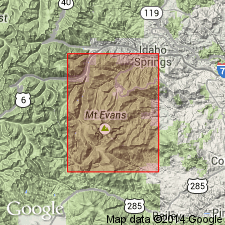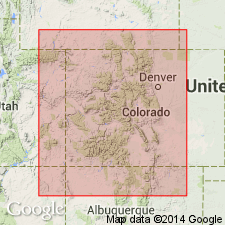
- Usage in publication:
-
- Rosalie granite*
- Modifications:
-
- Named
- Dominant lithology:
-
- Granite
- AAPG geologic province:
-
- Southern Rocky Mountain region
Summary:
Named. Type locality is in southeast corner of Georgetown quad on Deer and Elk Creeks, Clear Creek Co, CO in the Southern Rocky Mountain region. Is confined to the southern portion of the Georgetown quad. Consists of coarse-grained, massive, granular granite. The predominant constituent is salmon-pink microcline (often Carlsbad twinned). The feldspars vary from one-half to 2.5 inches long; they are rudely tabular, and are separated from one another by bands of quartz, feldspar, biotite, and magnetite. Minerals in order of abundance are microcline, quartz, orthoclase, oligoclase, and biotite. Zircon, apatite, and magnetite are accessory minerals. Is little deformed. Cuts an unnamed pre-Cambrian quartz monzonite. Is intruded by dikes of Silver Plume granite (new). Of pre-Cambrian age.
Source: GNU records (USGS DDS-6; Denver GNULEX).

- Usage in publication:
-
- Rosalie Granite
- Modifications:
-
- Overview
- AAPG geologic province:
-
- Southern Rocky Mountain region
Summary:
Abandoned in 1929, but has been used recently. Pikes Peak Granite in Rosalie lobe of batholith in central CO, Southern Rocky Mountain region. Listed with granitic rocks of circa 1,000 m.y. (or Precambrian Y) age group.
Source: GNU records (USGS DDS-6; Denver GNULEX).
For more information, please contact Nancy Stamm, Geologic Names Committee Secretary.
Asterisk (*) indicates published by U.S. Geological Survey authors.
"No current usage" (†) implies that a name has been abandoned or has fallen into disuse. Former usage and, if known, replacement name given in parentheses ( ).
Slash (/) indicates name conflicts with nomenclatural guidelines (CSN, 1933; ACSN, 1961, 1970; NACSN, 1983, 2005, 2021). May be explained within brackets ([ ]).

